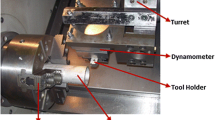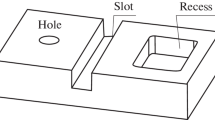Abstract
The current article presents an investigation into predicting tool wear in hard machining D2 AISI steel using neural networks. An experimental investigation was carried out using ceramic cutting tools, composed approximately of Al2O3 (70%) and TiC (30%), on cold work tool steel D2 (AISI) heat treated to a hardness of 60 HRC. Two models were adjusted to predict tool wear for different values of cutting speed, feed and time, one of them based on statistical regression, and the other based on a multilayer perceptron neural network. Parameters of the design and the training process, for the neural network, have been optimised using the Taguchi method. Outcomes from the two models were analysed and compared. The neural network model has shown better capability to make accurate predictions of tool wear under the conditions studied.
Similar content being viewed by others
References
Obikawa T, Matsumura T, Shirakashi T, Usui E (1997) Wear characteristics of alumina coated and alumina ceramic tools. J Mater Process Technol 63(1–3):211–216
D’Errico GE, Calzavarini R, Chiara R, Morrell R, Lay L (1995) Performance of ceramic cutting tools in turning operations. In: Ceramics: Charting the future. Techna Srl, pp 2327–2334
Xu C, Huang C, Ai X (2001) Mechanical property and cutting performance of yttrium-reinforced Al203/Ti(C,N) composite ceramic tool material. J Mater Eng Perform 10(1):102–107
Barry J, Bryne G (2001) Cutting tool wear in the machining of hardened steels. Part I: Alumina/TiC cutting tool wear. Wear 247(2):139–151
Barry J, Bryne G (2001) Cutting tool wear in the machining of hardened steels. Part II: Cubic boron nitride cutting tool wear. Wear 247(2):152–160
Chou YK, Song H (2005) Thermal modelling for white layer predictions in finish hard turning. Int J Mach Tools Manuf 45(4–5):481–495
Grzesik W, Wanat T (2005) Comparative assessment of surface roughness produced by hard machining with mixed ceramic tools including 2D and 3D analysis. J Mater Proces Technol 169(3):364–371
Paulo Davim J, Figueira L (2007) Machinability evaluation in hard turning of cold work tool steel (D2) with ceramic tools using statistical techniques. Mater Design 28(4):1186–1191
Lima JG, Ávila RF, Abrão AM, Faustino M, Paulo Davim J (2005) Hard turning: AISI 4340 high strength alloy steel and AISI D2 cold work tool steel. J Mater Proces Technol 169(3):388–395
Mukherjee I, Ray PK (2006) A review of optimization techniques in metal cutting processes. Comput Ind Eng 50(1):15–34
Taylor FW (1907) On the art of cutting metals. Trans ASME 28:310–350
Liu XL, Wen DH, Li ZJ, Xiao L, Yan FG (2002) Cutting temperature and tool wear of hard turning hardened bearing steel. J Mater Proces Technol 129(1–3):200–206
Thangavel P, Selladurai V, Shanmugam R (2006) Application of response surface methodology for predicting flank wear in turning operation. J Eng Manuf 220(6):997–1003
Dolinšek S, Šuštaršic B, Kopac J (2001) Wear mechanisms of cutting tools in high-speed cutting processes. Wear 250(1–12):349–356
Dodier RH, Henze GP (2004) Statistical analysis of neural networks as applied to building energy prediction. J Sol Energy Eng 126(1):592–600
Ibnkahla M (2001) Convergence properties and stationary points of the two-layer backpropagation algorithm used for non-lineal function modeling. In: Proceedings of the international joint conference on neural networks, Washington, DC, USA
Ezugwu EO, Arthur SJ, Hines EL (1995) Tool-wear prediction using artificial neural networks. J Mater Proces Technol 49(3–4):255–264
Li X, Nee AYC (1996) Monitoring cutting conditions for tool scheduling in CNC machining. Manuf Syst 25(4):377–383
Chao PY, Hwang YD (1997) An improved neural network model for the prediction of cutting tool life. J Intell Manuf 8(2):107–115
Niranjan Prasad K, Ramamoorthy B (2001) Tool wear evaluation by stereo vision and prediction by artificial neural network. J Mater Process Technol 112(1):43–52
Lin JT, Bhattacharyya D, Kecman V (2003) Multiple regression and neural networks analyses in composites machining. Compos Sci Technol 63(3–4):539–548
Özel T, Karpat Y (2005) Predictive modeling of surface roughness and tool wear in hard turning using regression and neural networks. Int J Mach Tools Manuf 45(4–5):467–479
Author information
Authors and Affiliations
Corresponding author
Rights and permissions
About this article
Cite this article
Quiza, R., Figueira, L. & Paulo Davim, J. Comparing statistical models and artificial neural networks on predicting the tool wear in hard machining D2 AISI steel. Int J Adv Manuf Technol 37, 641–648 (2008). https://doi.org/10.1007/s00170-007-0999-7
Received:
Accepted:
Published:
Issue Date:
DOI: https://doi.org/10.1007/s00170-007-0999-7




